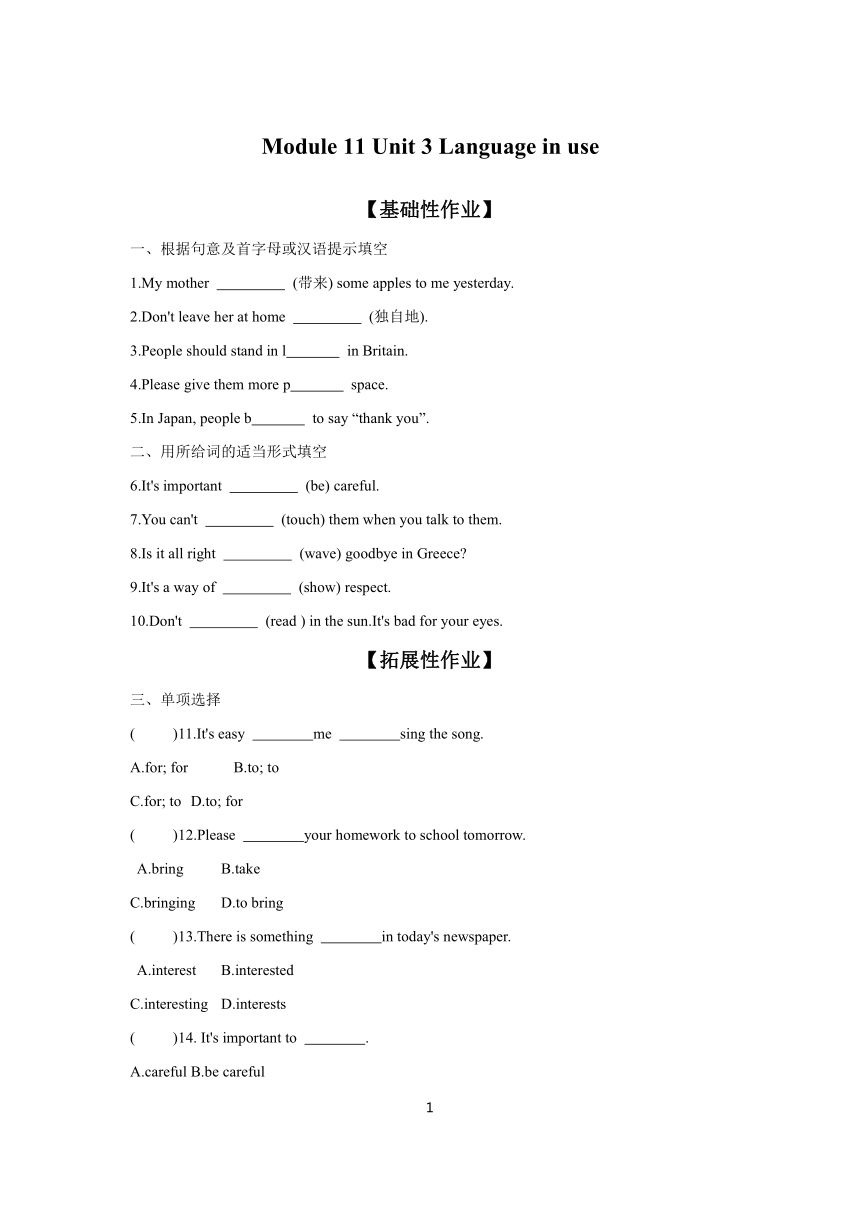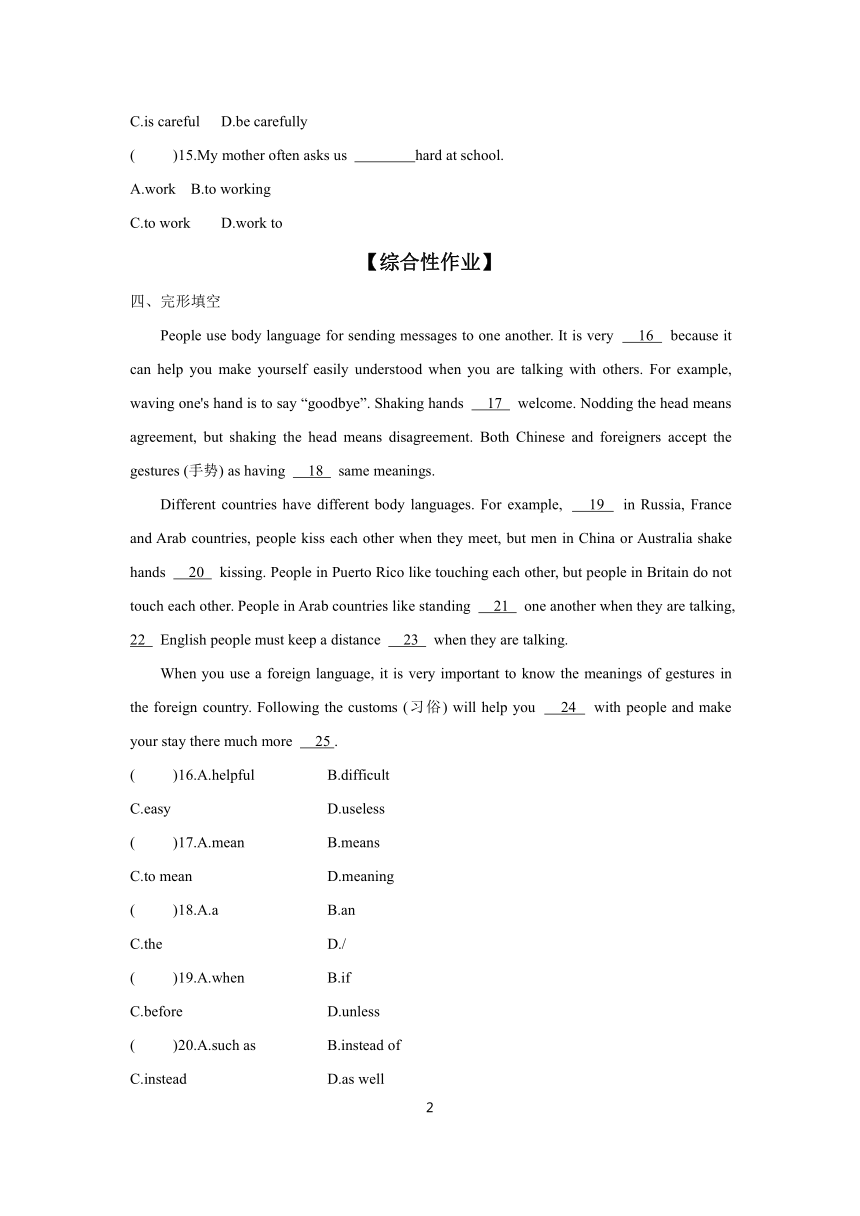Module 11 Unit 3 Language in use 课时作业(含答案)外研版英语七年级下册
文档属性
| 名称 | Module 11 Unit 3 Language in use 课时作业(含答案)外研版英语七年级下册 |  | |
| 格式 | docx | ||
| 文件大小 | 24.8KB | ||
| 资源类型 | 教案 | ||
| 版本资源 | 外研版 | ||
| 科目 | 英语 | ||
| 更新时间 | 2024-03-01 21:43:10 | ||
图片预览


文档简介
Module 11 Unit 3 Language in use
【基础性作业】
一、根据句意及首字母或汉语提示填空
1.My mother (带来) some apples to me yesterday.
2.Don't leave her at home (独自地).
3.People should stand in l in Britain.
4.Please give them more p space.
5.In Japan, people b to say “thank you”.
二、用所给词的适当形式填空
6.It's important (be) careful.
7.You can't (touch) them when you talk to them.
8.Is it all right (wave) goodbye in Greece
9.It's a way of (show) respect.
10.Don't (read ) in the sun.It's bad for your eyes.
【拓展性作业】
三、单项选择
( )11.It's easy me sing the song.
A.for; for B.to; to
C.for; to D.to; for
( )12.Please your homework to school tomorrow.
A.bring B.take
C.bringing D.to bring
( )13.There is something in today's newspaper.
A.interest B.interested
C.interesting D.interests
( )14. It's important to .
A.careful B.be careful
C.is careful D.be carefully
( )15.My mother often asks us hard at school.
A.work B.to working
C.to work D.work to
【综合性作业】
四、完形填空
People use body language for sending messages to one another. It is very 16 because it can help you make yourself easily understood when you are talking with others. For example, waving one's hand is to say “goodbye”. Shaking hands 17 welcome. Nodding the head means agreement, but shaking the head means disagreement. Both Chinese and foreigners accept the gestures (手势) as having 18 same meanings.
Different countries have different body languages. For example, 19 in Russia, France and Arab countries, people kiss each other when they meet, but men in China or Australia shake hands 20 kissing. People in Puerto Rico like touching each other, but people in Britain do not touch each other. People in Arab countries like standing 21 one another when they are talking, 22 English people must keep a distance 23 when they are talking.
When you use a foreign language, it is very important to know the meanings of gestures in the foreign country. Following the customs (习俗) will help you 24 with people and make your stay there much more 25 .
( )16.A.helpful B.difficult
C.easy D.useless
( )17.A.mean B.means
C.to mean D.meaning
( )18.A.a B.an
C.the D./
( )19.A.when B.if
C.before D.unless
( )20.A.such as B.instead of
C.instead D.as well
( ) 21.A.nearly B.far away
C.close to D.in front of
( )22.A.and B.or
C.however D.but
( )23.A.from B.to
C.of D.away
( )24.A.communicate B.talk
C.help D.walk
( )25.A.important B.interesting
C.comfortable D.successful
五、书面表达
在日常交往中,人们不仅用语言交流,而且还会用到丰富的肢体语言。肢体语言让你的交流更加容易、自然。请以“Body language”为题,写一篇70.词左右的短文,介绍一下你所了解的肢体语言。
Body language
______________________________________________________________________________
______________________________________________________________________________
______________________________________________________________________________
______________________________________________________________________________
______________________________________________________________________________
2
参考答案
Unit 3 Language in use
基础性作业
一、
1.brought 2.alone 3.line 4.personal 5.bow
二、
6.to be 7.touch 8.to wave 9.showing 10.read
拓展性作业
三、
11~15 CACBC
综合性作业
四、
16~20 ABCBB 21~25 CDDAC
五、
Body language
In our everyday life, we often use body language. We have to say goodbye. We put the forefinger in front of our mouth to say,“Please be quiet”. When we agree with someone, we nod our heads. If we don't, we shake our heads. But body language is different in different countries. When we speak with people from other countries, try to understand and respect their body language.
2
【基础性作业】
一、根据句意及首字母或汉语提示填空
1.My mother (带来) some apples to me yesterday.
2.Don't leave her at home (独自地).
3.People should stand in l in Britain.
4.Please give them more p space.
5.In Japan, people b to say “thank you”.
二、用所给词的适当形式填空
6.It's important (be) careful.
7.You can't (touch) them when you talk to them.
8.Is it all right (wave) goodbye in Greece
9.It's a way of (show) respect.
10.Don't (read ) in the sun.It's bad for your eyes.
【拓展性作业】
三、单项选择
( )11.It's easy me sing the song.
A.for; for B.to; to
C.for; to D.to; for
( )12.Please your homework to school tomorrow.
A.bring B.take
C.bringing D.to bring
( )13.There is something in today's newspaper.
A.interest B.interested
C.interesting D.interests
( )14. It's important to .
A.careful B.be careful
C.is careful D.be carefully
( )15.My mother often asks us hard at school.
A.work B.to working
C.to work D.work to
【综合性作业】
四、完形填空
People use body language for sending messages to one another. It is very 16 because it can help you make yourself easily understood when you are talking with others. For example, waving one's hand is to say “goodbye”. Shaking hands 17 welcome. Nodding the head means agreement, but shaking the head means disagreement. Both Chinese and foreigners accept the gestures (手势) as having 18 same meanings.
Different countries have different body languages. For example, 19 in Russia, France and Arab countries, people kiss each other when they meet, but men in China or Australia shake hands 20 kissing. People in Puerto Rico like touching each other, but people in Britain do not touch each other. People in Arab countries like standing 21 one another when they are talking, 22 English people must keep a distance 23 when they are talking.
When you use a foreign language, it is very important to know the meanings of gestures in the foreign country. Following the customs (习俗) will help you 24 with people and make your stay there much more 25 .
( )16.A.helpful B.difficult
C.easy D.useless
( )17.A.mean B.means
C.to mean D.meaning
( )18.A.a B.an
C.the D./
( )19.A.when B.if
C.before D.unless
( )20.A.such as B.instead of
C.instead D.as well
( ) 21.A.nearly B.far away
C.close to D.in front of
( )22.A.and B.or
C.however D.but
( )23.A.from B.to
C.of D.away
( )24.A.communicate B.talk
C.help D.walk
( )25.A.important B.interesting
C.comfortable D.successful
五、书面表达
在日常交往中,人们不仅用语言交流,而且还会用到丰富的肢体语言。肢体语言让你的交流更加容易、自然。请以“Body language”为题,写一篇70.词左右的短文,介绍一下你所了解的肢体语言。
Body language
______________________________________________________________________________
______________________________________________________________________________
______________________________________________________________________________
______________________________________________________________________________
______________________________________________________________________________
2
参考答案
Unit 3 Language in use
基础性作业
一、
1.brought 2.alone 3.line 4.personal 5.bow
二、
6.to be 7.touch 8.to wave 9.showing 10.read
拓展性作业
三、
11~15 CACBC
综合性作业
四、
16~20 ABCBB 21~25 CDDAC
五、
Body language
In our everyday life, we often use body language. We have to say goodbye. We put the forefinger in front of our mouth to say,“Please be quiet”. When we agree with someone, we nod our heads. If we don't, we shake our heads. But body language is different in different countries. When we speak with people from other countries, try to understand and respect their body language.
2
同课章节目录
- Module 1 Lost and found
- Unit 1 Whose bag is this?
- Unit 2 Are they yours?
- Unit 3 Language in use
- Module 2 What can you do ?
- Unit 1 I can play the piano
- Unit 2 I can run really fast
- Unit 3 Language in use
- Module 3 Making plans
- Unit 1 What are you going to do at the weekends?
- Unit 2 We're going to cheer the players.
- Unit 3 Language in use
- Module 4 Life in the future
- Unit 1 Everyone will study at home
- Unit 2 Every family will have a small plane.
- Unit 3 Language in use
- Module 5 Shopping
- Unit 1 What can I do for you?
- Unit 2 You can buy everything on the Internet
- Unit 3 Language in use
- Module 6 Around town
- Unit 1 Could you tell me how to get to the Nationa
- Unit 2 The London Eye is on your right.
- Unit 3 Language in use
- Revision module A
- Module 7 My past life
- Unit 1 I was born in a small village.
- Unit 2 I was born in Quincy.
- Unit 3 Language in use
- Module 8 Story time
- Unit 1 Once upon a time….
- Unit 2 Goldilocks hurried out of the house.
- Unit 3 Language in use
- Module 9 Life history
- Unit 1 He left school and began work at the age of
- Unit 2 He decided to be an actor.
- Unit 3 Language in use
- Module 10 A holiday journey
- Unit 1 What did you do?
- Unit 2 This morning we took a walk.
- Unit 3 Language in use
- Module 11 Body language
- Unit 1 They touch noses!
- Unit 2 Here are some ways to welcome them.
- Unit 3 Language in use
- Module 12 Western music
- Unit 1 It's so beautiful!
- Unit 2 Vienna is the centre of European classical
- Unit 3 Language in use
- Revision module B
